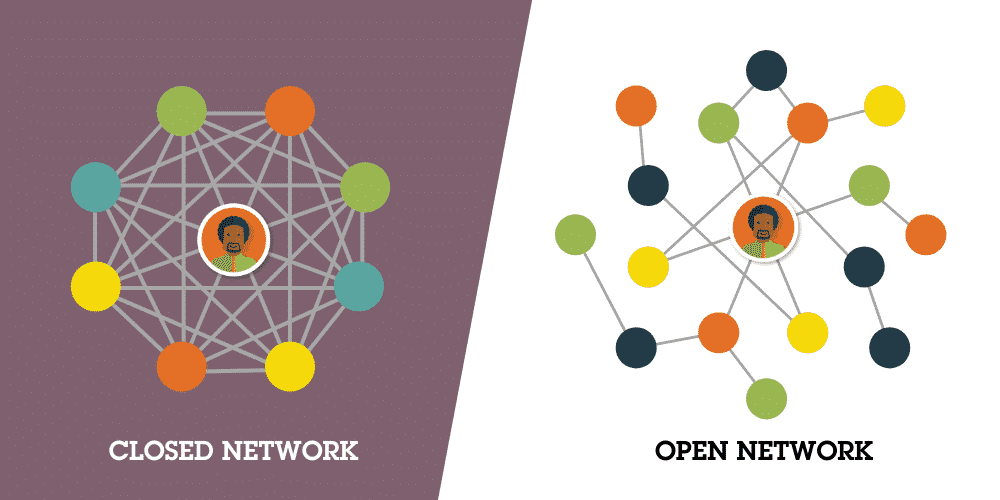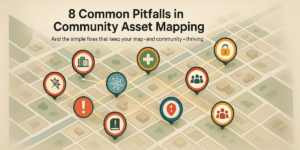Closed Vs Open Networks: When is Each Most Effective?

In network theory, a major focus of study is on the relative ‘openness’ of a network, and its relationship with network effectiveness. Specifically, people wonder whether the ideal is closed vs open networks. Coleman (1988) introduced a theory that claims tighter, densely interconnected, ‘closed’ networks provide more knowledge and resources that help boost impact. However, Burt (1992) claimed the opposite: that spaced out, disconnected, ‘open’ networks access more diverse ideas and information. So what’s the deal? Is it better to embed yourself in a web of close connections, or is better to build vast, open networks with people unlike yourself?
As with most concepts in network science, the answer is “it depends.” Rather than give a single answer, Burt proposed that open and closed networks are both useful, for different uses. Understanding the effects of network positioning requires consideration of the conditions in which you’re collaborating. First and foremost, you have to consider whether your goal is exploitative or exploratory learning. Here’s what these two terms mean in practice.
Exploitative Vs Exploratory Innovation in Closed Vs Open Networks
While learning and sharing information is a goal of nearly all networks, there are different ways to innovate and learn collaboratively. Whether you should build closed vs open networks depends on which type of learning and innovation you hope to engage in. Here is a brief intro to exploitative vs exploratory learning in a network setting.
Exploitative Learning Networks
Exploitative learning involves leveraging and refining knowledge, information and ideas that already exist to improve your organizational capacity and effectiveness. Essentially, you want to get large quantities of detailed information that will help you refine the way you do your work. For example, sharing best practices among network members is a form of exploiting existing knowledge, rather than generating completely new ideas. In such networks, the solution space is well-defined, and the search for knowledge is local and highly specific to the issue at hand.
In an exploitative learning environment, close networks are widely considered the best strategic approach to positioning. The access to redundant and refined sources of knowledge from those they know, and trust, is important for transmitting information and improving innovations bit by bit through collective efforts.
Exploratory Learning Networks
Exploratory learning, on the other hand, involves generating new innovations, ideas and solutions by leveraging new ways of thinking and doing things, especially from those you do not know or work with well. This type of learning involves an ill-defined solution space, with a wide search that places a premium on newly developed, rather than refined, information. An example would be a Regenerative Network that aims to develop totally new solutions to shared problem by combining diverse perspectives, skillsets and experiences in new ways.
Groups focused on exploratory learning are most successful in open, disconnected networks that increase their chances of being introduced to new ways of thinking and ideas. As connections with those they already know rarely generate new knowledge, the key here is building diverse networks with structural holes that facilitate interaction between new partners.

Measuring and Improving Your Network Position
Once you have an idea of whether you want to build open or closed networks, the next issue is measuring your network position so you can make goals that can track your progress. Organizational network analysis is a powerful tool for doing so, using network science measures to quantify the structure of your network.
PARTNER, our platform for tracking and adapting network strategies includes “betweenness centrality.” This measures how many connections are between two partners. A closed network has low betweenness centrality as partners are interconnected to most other members, requiring very little intermediaries to share ideas and info between them. An open network has high betweenness centrality, as members are more disconnected and spread out. This makes it a helpful metric for tracking your positioning progress.
Closed Vs Open Networks: A Review
Building a network of partners is no easy task. Trying to figure out the most strategic way to connect with your partner organizations can be extremely difficult and confusing. If you aren’t sure whether you should focus on creating a closed, densely interconnected network, or a more open, diverse network, consider whether you’re engaged in exploitative or exploratory learning and innovation. That should help guide your efforts towards greater success and collective impact.
SOURCES:
Coleman, J. (1988). Social Capital in the Creation of Human Capital. American Journal of Sociology, 94, S95-S120. Retrieved February 12, 2021, from http://www.jstor.org/stable/2780243
Burt, Ronald S., Structural Holes: The Social Structure of Competition (1992). University of Illinois at Urbana-Champaign’s Academy for Entrepreneurial Leadership Historical Research Reference in Entrepreneurship, Available at SSRN: https://ssrn.com/abstract=1496205

About the Author: Alex Derr, M.P.A.
Director of Marketing & Communications
Alex joined VNL in 2017, originally supporting our events. He now helps manages our communications and marketing strategy and content development work. Alex creates blogs, infographics, reports, and other content while managing our web and social media presence. He also runs our email marketing campaigns, tracks analytics, and conducts market research to drive our strategy. He supports our entire team with copywriting, graphic design and research, and helps with events, webinars, demos, and other online learning. When he isn’t at work Alex spends his time climbing 14ers (30 done, 28 to go!) and blogging on his own website, The Next Summit Blog.




